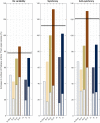Direct and ancillary benefits of ecosystem-based fisheries management in forage fish fisheries
- PMID: 34288221
- PMCID: PMC9285690
- DOI: 10.1002/eap.2421
Direct and ancillary benefits of ecosystem-based fisheries management in forage fish fisheries
Abstract
Natural resource management is evolving toward holistic, ecosystem-based approaches to decision making. The ecosystem science underpinning these approaches needs to account for the complexity of multiple interacting components within and across coupled natural-human systems. In this research, we investigate the potential economic and ecological gains from adopting ecosystem-based approaches for the sardine and anchovy fisheries off of the coast of California, USA. Research has shown that while predators in this system are likely substituting one forage species for another, the assemblage of sardine and anchovy can be a significant driver of predator populations. Currently, the harvest control rules for sardine and anchovy fisheries align more with traditional single species framework. We ask what are the economic and ecological gains when jointly determining the harvest control rules for both forage fish stocks and their predators relative to the status quo? What are the implications of synchronous and anti-synchronous environmental recruitment variation between the anchovy and sardine stocks on optimal food-web management? To investigate these questions, we develop an economic-ecological model for sardine, anchovy, a harvested predator (halibut), and an endangered predator (Brown Pelican) that includes recruitment variability over time driven by changing environmental conditions. Utilizing large-scale numerical optimal control methods, we investigate how the multiple variants of integrated management of sardine, anchovy, and halibut impact the overall economic condition of the fisheries and Brown Pelican populations over time. We find significant gains in moving to integrated catch control rules both in terms of the economic gains of the fished stocks, and in terms of the impacts on the Brown Pelican populations. We also compare the relative performance of current stylized catch control rules to optimal single species and optimal ecosystem-based fisheries management (EBFM) across ecological and economic dimensions, where the former trade-off considerable economic value for ecological goals. More generally, we demonstrate how EBFM approaches introduce and integrate additional management levers for policymakers to achieve non-fishery objectives at lowest costs to the fishing sectors.
Keywords: bioeconomics; natural resource management; optimal control; pseudo-spectral numerical techniques.
© 2021 The Authors. Ecological Applications published by Wiley Periodicals LLC on behalf of Ecological Society of America.
Figures





References
-
- Alder, J. , Campbell B., Karpouzi V., Kaschner K., and Pauly D.. 2008. Forage fish: from ecosystems to markets. Annual Review of Environment and Resources 33:153–166.
-
- Brodziak, J. , and Link J.. 2002. Ecosystem‐based fishery management: what is it and how can we do it? Bulletin of Marine Science 70:589–611.
-
- Clark, C. W. 1990. Mathematical bioeconomics: the optimal management of renewable resources. Volume 1, Second edition. John Wiley & Sons, Inc, New York, New York, USA.
-
- Donovan, P. , Bair L. S., Yackulic C. B., and Springborn M. R.. 2019. Safety in numbers: Cost‐effective endangered species management for viable populations. Land Economics 95:435–453.
-
- Essington, T. , Baskett M., Sanchirico J., and Walters C.. 2015a. A novel model of predator prey interactions reveals the sensitivity of forage fish: Piscivore fishery trade‐offs to ecological conditions. ICES Journal of Marine Science 72:1349–1358.

